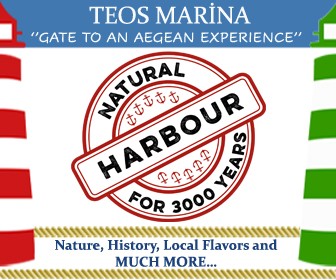Corinth Canal - General Info
Description:
Opened in 1893, the Corinth Canal separates mainland Greece from the Peloponnese. The Canal is 3.2NM long, 25m (81 ft) wide and has a max. draft of 7m. The limestone from which the canal is cut rises to 76m above sea level at its highest point.
The canal came under private management in September 2001 and is too narrow for commercial vessels (apart from some small cruise ships), so is predominantly a tourist attraction and useful short cut for small craft. The town of Corinth (Korinthe in Greek) lies just west of the northern end of the canal.
The canal operates 24 hours, 7 days per week except on Tuesdays from 06.00 to 18.00, when regular canal maintenance is carried out.
There are hydraulic road bridges at either end of the canal which sink down into the water to allow vessels to pass.
This is the most expensive canal transit in the world (approx. 200 Euros plus for a 12m yacht). However, it does save alot of time not having to sail around the Peloponnese.
Entrance Notes and Cautions:
ALERT: Following extensive repair work on the Canal since January 2021 when a number of serious landslides closed the Canal to all shipping, the Canal re-opened on 1 May, 2024 returning to normal and full 24 hour operation. However, it is scheduled to close again from 4 November, 2024 until March 2025 to continue restoration works. Read News here.
See the Corinth Canal website for updates (in English), or contact administration/customer service (csd@aedik.gr).
The Canal is illuminated at night by electric (natrium vapour) lamps of amber colour, placed opposite each other in pairs, with a distance of 100 metres between each pair. The purpose of these is to mark out the flanks of the Canal by night. There is also an auxiliary lighting network with ordinary light bulbs, fitted in the same order as that above.
Vessels approaching the Canal during the night are effectively guided on the Corinth side by the flashing white beacon of the Melangavion lighthouse (with a range of 20 miles), and on the Saronic Gulf side by the flashing red Sousakion lighthouse (with a range of 18 miles).
A current of 1-3 knots can flow either direction in the canal depending on where the wind is blowing from. Useful information on winds and currents can be found in the Corinth Canal General Info.
Paperwork and fees are dealt with at the Eastern end of the Canal in Isthmia.
Position:
37°56.67’N, 22°56.32’E (Corinth Harbor)
Last updated: October 2024
Read and Post Related Comments
If you have information for this section, or feedback on businesses used, please let us know at editor@noonsite.com. We also welcome new information about businesses you have used (see Related Businesses).
Next Section: Profile: Clearance
Related to following destinations: Corinth Canal, Greece, Gulfs of Patras & Corinth
Port Navigation
Courtesy Flag Discounts


YachtFlags.com provides high quality courtesy flags that are manufactured in durable Knitted Polyester fabric. Knitted so that the fabric itself does not deteriorate in the constant movement that marine flags are usually exposed to, and polyester so that the flag does not weaken in the strong UV-light usually found in the main sailing areas of the world.
YachtFlags.com offers a discount to Noonsite members.
Use the coupon code NOONSITE-5A2B when checking out to get 10% off today.
Buy Now On YachtFlags.comMain Ports - Greece
Courtesy Flag Discounts


YachtFlags.com provides high quality courtesy flags that are manufactured in durable Knitted Polyester fabric. Knitted so that the fabric itself does not deteriorate in the constant movement that marine flags are usually exposed to, and polyester so that the flag does not weaken in the strong UV-light usually found in the main sailing areas of the world.
YachtFlags.com offers a discount to Noonsite members.
Use the coupon code NOONSITE-5A2B when checking out to get 10% off today.
Buy Now On YachtFlags.com





I called the Corinth Canal customer service number today and was told that the canal would open 1 June 2023. Happiness!
Thanks so much for reporting this information, it’s very helpful.
The cost to transit the canal is exuberant to say the least. There is nobody to take lines from boats docking at the pay station (East entrance) the dock is high more suitable for ships and the docking cleats are huge and far apart. It is really not good enough given the cost to use this facility that they don’t provide assistance with docking.
There are several street dogs hanging out on the dock, beware if you have pets to keep them on board, these dogs get aggressive with strange dogs.
One should complain to the pay master about the lack of help mooring, perhaps then they may do something about it.
It is a great experience! During 5 km you cross the canal between the huge mountains… First, you must call 11 VHF to ask for the permission and at the exit you will have to go to the office to pay. Our cata 420 200eur
We stayed 2 nights in the Corinth Yacht Harbour in Mid October 2014, on the Middle pier. Our draft of 1.7 metres was fine (although the depth gauge read 0.00!).
We were one of 2 yachts along side, both mid 30fters. Fresh water, no shore power, no fees (apparently ever). We were greeted by an elderly local chap called Jonathan (Stuart?), an Englishman (Cornish) ex-merchant navy man.
He helped us tie up and was a wealth of good information & advice. He appeared a bit down on his luck so we took him and his pet dog ‘Tico’ to dinner nearby and were treated to and evening of wonderful stories, fierce intelligence & good company.
Jonathan will look after your boat while you’re away, seems to know everyone in the area & speaks fluent Greek. I think he supplements is income (if any!) from helping visiting boaties to the harbour so if you’re greeted by a scruffy chap with a hat as you pull in.
Say hello, let him help you and thank him with a few euros. Its meeting colourful characters like Jonathan that makes sailing & travel so rewarding.
If you have any updates on our mate please let me know!
Posted on behalf of SY Funny Girl: Corinth Harbour
In the small harbour there is only place for 5 x 15m yachts.
Warning: at the middle pier there is only 1.60 meters of water depth, it can vary 80 cm under influence of wind.
Some concrete anchor blocks have less water above them and will hit your keel, so enter slowly to the pier.
ALternatively moor in the commercial harbour, there is a lot of space, but do not use the outer, huge breakwater as sometimes there arrives a 220-meter long ferry. Better ask the Port Police by VHF on channel 12 first.
The first 400 meters of the commercial quay, as seen from the small harbour, can be used either alongside or stern or bows to. I saw some alongside, space enough.
The city is modern, has several supermarkets, a pedestrian area and a lot of ATM machines.
Water for free with a hose at the middle pier.
Nobody came for money or registration.
Posted on behalf of SY Funny Girl:
We passed the canal yesterday the 11th of August, we did an overnight stay in Corinth city harbour. There is good quality drinking water with a hose at the middle pier, space for 3 x 15 m yachts.
Nobody asked for money, the Port Police passed, had a look at us, but said nothing else other than “Hello”. Next morning, from this harbour, we called on VHF channel 11 the canal control.
Told them that we were in the city harbor, and we were lucky, we could come directly to the entrance of the canal, which is only 1.25 mile away. They prepared the bridge at the western entrance and we could pass without waiting.
At the east side we moored without trouble and paid (11.95 X 3.95) 181,86 € with our credit card. All went smoothly and professional, within 10 minutes.
The canal passage itself is a must, it is spectacular. The canal is 25 meters wide and at the east side 52 meters high, but it looks and feels much narrower and higher. We had a 2 knot current against us.
Posted on behalf of Ignatios Souvatzis:
I passed the Corinth Canal from Saronikos to Gulf of Corinth last week. We overlooked VAT which increased our fee considerably (currently 23%). E.g. with our Lutra 52, we paid EUR 313.65 instead of the expected EUR 255.-
Btw, the online computation form adds the VAT explicitly.
http://www.aedik.gr/frontend/fee_calculator.php
Ignatios Souvatzis
Corinth Canal (Eastern Entrance)
We anchored overnight to the north side of this entrance in about 7 meters of water (37°55.1626 N 023°00.8364 E). Rather than take the boat alongside, in the morning we took the dinghy to make payment.
There is a great place to tie up a dinghy on the inside of the docking pontoon near the pedestrian bridge from the pontoon to land. I have not seen this mentioned anywhere.
Bill
BeBe Amel 53